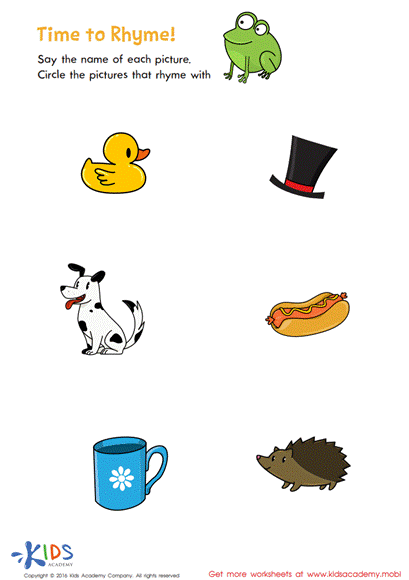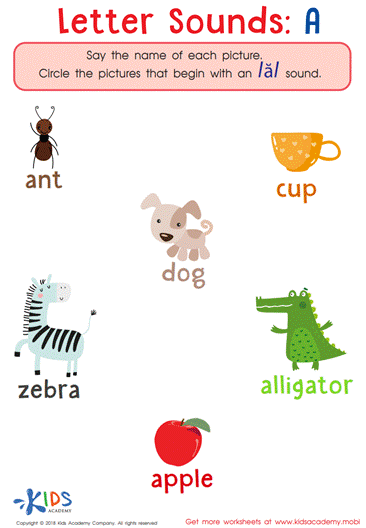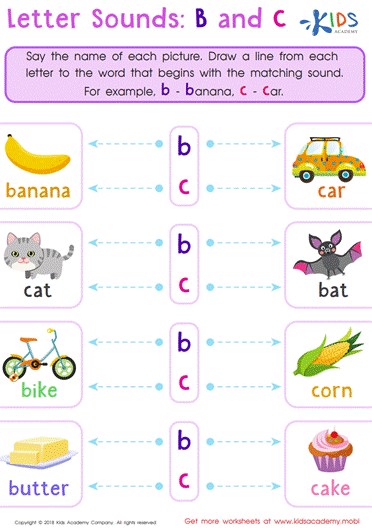-
English
-
English Pre-K
-
Unit 1: Early Literacy Skills
-
ABCs
- Pre-writing Activities
- Letter A
- Letter B
- Letter C
- Letter D
- Letter E
- Letter F
- Letter G
- Letter H
- Letter I
- Letter J
- Letter K
- Letter L
- Letter M
- Letter N
- Letter O
- Letter P
- Letter Q
- Letter R
- Letter S
- Letter T
- Letter U
- Letter V
- Letter W
- Letter X
- Letter Y
- Letter Z
-
Phonological Awareness
- Rhyming Words
- Letter Sounds B, C, D, and F
- Letter Sounds G, H, J, and K
- Letter Sounds L, M, N, and P
- Letter Sounds Q, R, S, and T
- Letter Sounds V, W, X, Y, and Z
- Letter Sounds A, E, and I
- Letter Sounds O and U
- Beginning Sounds
- Matching Letters to Sounds
-
ABCs
-
Unit 2: Vocabulary
-
Common Words
- Sorting Words into Categories
- Color Words
- Verbs and Adjectives
-
Sight Words
- Sight Words 'I' and 'Can'
- Sight Words 'You' and 'Like'
-
Common Words
-
Unit 3: Print Awareness
-
Parts of a Book
- Working with a Book
- Spaces Between Words
- Text and Illustrations
-
Picture Books and Poems
- Picture Book Text Features
- Poem Text Features
- Signs and Labels in the Community
-
Parts of a Book
-
Unit 4: Reading Literature
- Questions About Stories
- Discussing Stories
-
Unit 5: Reading Informational Texts
- Retelling Details in a Text
- Questions About a Text
- Connections Between Events
- Text Features
- Describing Illustrations
-
Unit 1: Early Literacy Skills
-
English Pre-K
-
Math
-
Math for Pre-Kindergarten
-
Logic and Geometry
-
Matching and Sorting
- Same and Different
- Which One Is a Little Different?
- Objects That Go Together
- Sorting by Color and Size
- Sorting The Same Group in Different Ways
- Patterns
-
Shapes
- Shapes in Our Environment
- Naming Shapes Regardless of Size
- Making Shapes in Preschool
- Comparing Shapes
- Relative Positions
- Sorting Shapes
-
Matching and Sorting
-
Early Number Sense
-
Numbers 1–5
- Counting to 3
- Counting to 5
- Arranging Objects up to 3 Objects
- Arranging up to 5 Objects
- Writing Numbers 1–5
-
Numbers 1–5
-
Numbers up to 10
- Counting to 10
- Arranging up to 10 Objects
- Number 0
- Writing Numbers 6–10
- Breaking Down Numbers 6-10
-
Logic and Geometry
-
Math for Pre-Kindergarten
Teaching Phonological Awareness to Preschoolers
The development of a child’s reading skills heavily relies on your approach as a parent and educator. Learning how to read doesn’t happen overnight, it requires years of priming and preparation, starting from infancy. Nevertheless, active intervention starts occurring at the pre-k stage, that’s when parents introduce pre-reading skills to their children. One of the key pre-reading skills for early literacy development, and our main topic for this article, is phonological awareness. Phonological awareness is the ability to hear, identify and manipulate individual sounds. For your child to master this skill, they need to practice its sub-skills first. In this section, we will cover 4 sub-skills to phonological awareness:
- Recognizing words that rhyme
- Identifying letter-sounds
- Isolating initial sounds
- Recognizing letter-sound correspondence
Recognizing words that rhyme
Rhyme awareness is an important sub-skill of phonological awareness. It consists of both the ability to hear rhyme, and to produce it. When parents sing nursery rhymes to their babies, they are developing their phonological skills through introducing rhyming words. Thus, this skill starts very early on. To get your child to practice their rhyming words, offer them some activities and worksheets like our “Time to Rhyme!” rhyming worksheet below. You can find more activities like this in our great collection of material on the Kids Academy website here.
Identifying Letter-Sounds
The second sub-skill children need to develop to achieve phonological awareness is the ability to identify letter-sounds. This skill requires the child to be able to listen to words and identify and recognize individual sounds. Letter-sounds are divided into two categories: consonants and vowels. In this chapter, you will teach your child the sound of each letter individually and help them practice how to hear and identify each, and differentiate between them, through engaging them in useful activities. To find more fun and educational materials like the worksheets below, visit Kids Academy website, or click here.
Initial Sounds
Being able to identify and isolate the initial sound of a word is an integral part of acquiring phonological awareness skills. It is the first step to teach your child before moving on to the middle and end sounds because it is easier for children to grasp. Teaching this skill can happen on an everyday basis, for example through stressing the first sound to point out similarities between words. Another handy tool for teaching initial sounds is using these interactive worksheets from our Kids Academy website. This “Match-Up Game: Beginning Sounds” worksheet is an example of the material provided:
Letter-Sound Correspondence
Each sound has a corresponding shape, or grapheme called a letter. For a child to learn how to read and write, they should first learn which of the letters correspond to what sound. This skill is called “letter-sound correspondence”, it is the fourth sub-skill we tackle in our phonological awareness unit. To establish this knowledge of correspondence between letter and sound, it is important to use play and activities. In the selection here, you can find several Kids Academy worksheets that will help your child revise their knowledge. For example, this colorful “Pick a Picture” worksheet is a great way to help your child practice their word recognition and letter-sound correspondence.
Working on these four sub-skills is vital for achieving phonological awareness. The more they practice these skills and achieve the appropriate phonological awareness skills, the better their reading and writing skills will be in the future. Most of these skills come naturally to children as they grow and develop cognitively, thus there is no need to rush the process. You can ensure the success of the process by regularly playing around with language, words and sounds. Use our interactive catalogue to find more specific articles on different aspects of phonological awareness.






